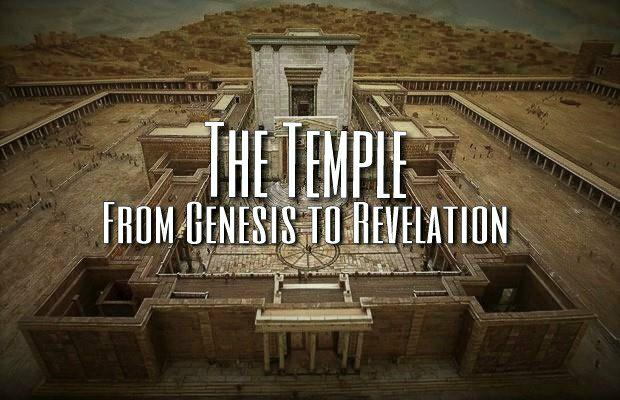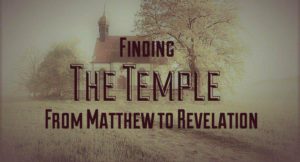Lesson 5 will mark the next to last lesson in this mini-series entitled The Bible Themes Series. There are many more themes than the Garden of Eden, the Exodus, and the Temple of God that span the Bible from beginning to end. Lessons 1-4 have hopefully given you a taste of what your Bible study has been lacking up to now. Use these beginner lessons and the other tools from Five Minute Bible Study to enhance your personal Bible study and unlock what is the single plot line of the Bible- the scheme of redemption.
What is the temple? Do not misunderstand me in this brief study. The Temple of God was a real, historical place, just like the Garden of Eden was a real, historical place. Just the same, the Temple of God functions not only as a real place in Israel’s history, but as an image or symbol of something greater that was to come during future days of redemption. Here is a good definition of the Temple of God in the most elementary terms that English offers-
the dwelling place of God.
In John 2:19 Jesus says, “Destroy this temple, and in three days I will raise it up.” In 2:21 we understand, “But He was speaking of the temple of His body.” This initial statement and footnote by Jesus and John will prove valuable to understanding the fulfillment of the Temple of God in the New Testament. From this terminology we learn an important definition. Jesus uses the word “temple,” the Greek noun meaning “temple, palace, or house”, but this Greek noun comes from a Greek verb which means “to dwell”. In John 4:21-24, Jesus teaches in part that while God’s dwelling place has been confined to a temple/house in Jerusalem for a long time, this will not be the case under the new covenant. If the word temple means “dwelling place”, then Jesus is saying, “Wherever God dwells is His temple.” So let’s go back to Genesis and trace God’s dwelling place all the way to Revelation.
The Temple in Genesis- There is no temple in Genesis! Someone is thinking that right now. But, did God have a dwelling place in Genesis? If so, then God had a temple in Genesis.
“And they heard the sound of the Lord God walking in the garden in the cool of the day…” (Gen. 3:8)
This verse is stating in narrative form that the Garden of Eden was the dwelling place (temple) of God. When Adam and Eve sinned, they were cast out of God’s presence (Gen. 3:23). It would take ransom to return man to this temple, see Lesson 17.
In Genesis 12:7 the Bible says that God “appeared” to Abram in the land of Canaan. In 12:8 it then says Abram moved to Bethel. All this signifies that when God promised to make Abram a great nation in Genesis 12, He dwelt with Abram, at least momentarily. How do I know this? Because in Genesis 28, Jacob took a power nap on a rock while fleeing from his brother Esau. God appeared to Jacob in a dream, and afterward Jacob named that place Bethel. Bethel literally means “the house of God” (Gen. 28:17). Wherever God dwells is His temple, and God is not confined to a visible structure.
The Temple of Solomon– While on Mt. Sinai, Moses is given instruction to build a tabernacle (Exodus 26). That tabernacle would serve as God’s temporary dwelling place, evidenced by Exodus 33:7-17. In 2 Samuel 7, David seeks to build God a permanent house, to which God assigned the task of building to Solomon. Upon finishing and dedicating the Temple of God in 2 Chronicles 5:13-14, the Bible records that God’s glory in the form of a cloud filled (dwelt in) the entire structure so that no one could stand to be inside. Furthermore, Solomon proceeded to shout, “I have surely built You an exalted house, and a place for You to dwell in forever!” (2 Chron. 6:2). While the tabernacle was portable and temporary, the temple would be stationary and permanent, as long as Israel was faithful to the covenant of Mt. Sinai (Exodus 34:10-28). Both of these dwelling places look forward to something greater. They look forward to a time when God will dwell with His people in a fashion that He has never dwelt with His people before.
The Temple Destroyed– In Ezekiel 10:18, the prophet has a vision of God’s glory departing from the temple in fiery anger. Ezekiel is with captive Jews in Babylon at this time, while the leftover Jews are in Jerusalem’s temple, waiting to be slaughtered by Babylon. Ezekiel’s vision symbolizes the fact that God is no longer dwelling with His people in the temple, because the people have been unfaithful to the covenant. The temple is shortly thereafter burned to ashes by King Nebuchadnezzar in the year 586 B.C. (2 Kings 25:9). This single verse in 2 Kings is a climactic point in the Old Testament. The glory of God is gone. God is no longer with His people.
Enter Jesus the Son of God.
This concludes our brief study of the Temple of God in the Old Testament. Log on next week to finish the story of the temple as its significance is unfolded by Jesus from Matthew to Revelation.



